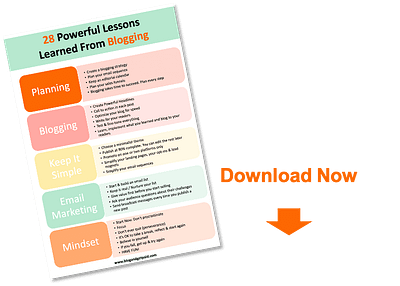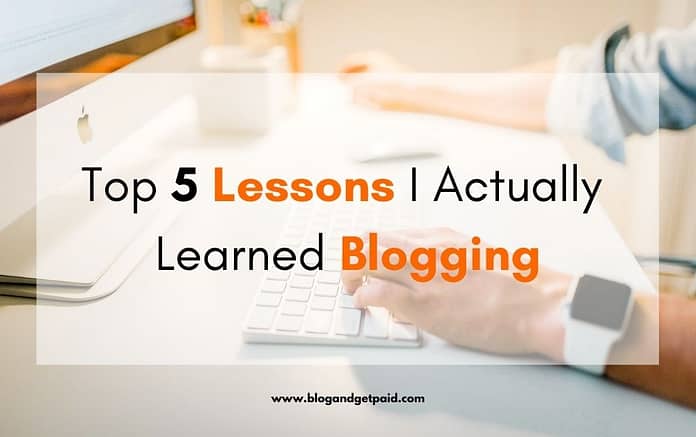Last Updated on July 14, 2023 by Nadim Alamuddin
If you have read my “About My Blog” section, you would have learned that I started blogging when I was doing network marketing. It was then that I recognized I had a passion for writing and transferring knowledge, so I continued on my blogging journey. Most bloggers start writing a personal journal that develops into a blog. Others start a blog as a business venture, to help them make money. No matter how you started blogging, chances are that you have picked up valuable lessons along the way. This post highlights the lessons I learned throughout my blogging journey. Although I have learned a lot of lessons, I’m only highlighting those that would be applicable to most bloggers.
For a comprehensive, printable list of my lessons learned blogging, download “28 Powerful Lessons Learned From Blogging”, available below.

Table of Contents
1. Plan Everything
Whatever you decide to do on your blog, plan it and plan it well. This topic can be broken down to the following:
Blogging Strategy
You need to know why you’re starting a blog and what you want to get out of it. It could be a personal journal or it could be a full fledged business (or anything in between). Whatever your objectives, they must be clear.
It’s wise to write down your objectives. Short, mid and long-term goals. Once you have set these goals, you should make them SMART and start monitoring them over time. I would recommend you schedule your activities using an editorial calendar. And stick to it, fine-tuning it as and when required. This gives you structure and keeps you focused.
Here’s a great post on how to Create A Blog Content Strategy.
Blog Design
Once you know why you’re starting a blog, you should plan on a blog design. I’d recommend that you have a basic idea of how your blog should look like. Visit blogs in the same niche that you’ll be writing about, and visit blogs that aren’t. Here are some elements to check out for:
- Homepage or blog posts – a lot of blogs start out with a homepage, or landing page. Some blogs have a list of their blog posts.
- Fonts and colors – recently, dark or black sites are popular. How would your blog look?
- Opt-ins – how will you be attracting your readers to subscribe to your blog?
Email Marketing
As you start building your mailing list, you ideally would want to send email sequences to your subscribers. These should be well planned, and written in a way to nurture your relationship with your readers. As your email list grows, you will find that you will start to segment your list, build new sequences with automation and this will add complexity to your tasks. Without proper planning, your email marketing strategy could easily get out of control.
2. Start Now
Once you have made a decision to start your blog, jump right in. Do not procrastinate. A lot of us have a tendency to want to learn everything before embarking on a new journey. If you do so, you’ll never start. Just do it. You’ll have plenty of time to learn along the way.
If you don’t know where to start, check out my post “From Zero to Blog In 5 Steps” and download the Infographic (found at the bottom of that post), which serves as a printable guide for you.
3. Start Simple
When you start out, keep it as simple as possible. This is a lesson learned about blogging that is easier said than done, so I’ll be specific to areas where you need to take care.
Blog Theme:
With so many free and premium themes available for WordPress, you can spend quite a bit of time choosing the best theme for your blog. In my opinion, as you start out, don’t spend too much time choosing. You can use the theme filter option in WordPress to select the elements that matter the most for you and then choose a theme that ticks all the boxes.
You can also invest in a theme, which is what I did. I chose that path because I didn’t want to waste time (which equals money) checking lots of free themes and finding out they’re not configurable to my needs. With a premium theme, I got the principal elements I needed, fast.
So, to recap, I’d choose a theme that is responsive (for mobile), fast (better user experience) and minimalistic (blogging, after all is about writing more than graphics and photography). You can always change your theme later.
Here are a couple of blog posts that should help you with picking a theme:
Opt-Ins / Lead Magnets:
When starting out, use minimalistic forms, such as those available in ConvertKit (free version) or MailChimp. Your offers should also be simple and easy to create. You can start with Printables, Infographics, Planners, and e-mail courses. These are relatively easy to do and used as lead magnets to build your email list.
Blog Post Promotion:
When we publish our blog post, we sometimes want to promote it to every social media platform we can think of. Do not do that. Instead, concentrate on one or two platforms where you have a good following or where you can bring in good traffic. Start small. In my case, I get about 75% of my traffic from Pinterest, so this is where I concentrate my promotion techniques on. I also work on SEO for organic search traffic.
It’s important to limit your promotion techniques to one or two platforms until you become proficient at them. You can then expand.
4. Implement What You Learn
The blogging journey is a learning journey. A lot of times though, we learn a new skill or a tool but, instead of implementing what we learned, we jump to the next new lesson and keep on absorbing information without actually implementing anything. Not only does that stall your progress, but it fails to reinforce what you just learned.
So, let’s say you learn how to create a Pinterest pin on Canva. Once you’ve completed that lesson, start creating pins on Canva. And, as many of us will find out, implementing what we just learned is not as easy as the “trainer” made it look. Which is why you absolutely need to implement it and keep implementing it until you become proficient at it.
And, guess what? As you become more proficient at it, you can now start teaching your readers about it. Not only that, but you’ll have inside information about the pros and cons of the tool so your reader can appreciate the experience you’ve had implementing it. This is one of the most important lessons I learned blogging.
Learn, Implement & Blog About ItClick To Tweet5. If It Doesn’t Work, Try Again & Again
As briefly mentioned in lesson 4 above, sometimes we will have a hard time implementing a lesson we just learned. Worse yet, we do exactly what the trainer explained, but for whatever reason, we don’t get the same results as the training explained! This is typical and very common.
The biggest lesson to takeaway here is that you need to implement the lesson in different ways and for different data sets. Suppose you just learned how easy it is to create a new digital product and use it as a lead magnet to build your mailing list. Let’s say you take a few hours to implement this and you set it up on your blog, eagerly waiting for people to start signing up to your mailing list. After all, that’s exactly what the trainer said will happen. Yet, after a few days, you find out that no one signed up!
If this sounds familiar, you’re not alone. It’s what you do with it that will determine your ultimate success. Most of us will quit and go on learning about some other strategy, thinking that the one we learned just doesn’t work. Nothing can be further from the truth.
Instead of quitting, you should go back and test what you learned with different sets of data. For example, you could change the image you used, the text, the opt-in/lead magnet. You could add a landing page to increase your conversions. There are a lot of different ways you can test to make sure your offer starts working.
The trainer may have an already established subscriber list that’s warm, because they’ve been nurturing it for a while now. They may have a steady stream of traffic to their blog, so whatever they present as a lead magnet will get a few bites right off the bat. Your case will be different. So, do yourself a favor. Persevere and believe in yourself!
Recap & Takeaways
As mentioned in this blog post, the five most powerful lessons I learned blogging are:
- Plan Everything
- Start Now
- Start/Keep It Simple
- Implement What You Learn
- If It Doesn’t Work, Try & Try Again
Of course, there are more lessons and blogging tips I have learned which I am including in the Printable List that you can download below, which includes the above five.

It’s your turn now. If you look back at your blogging career, no matter how short or long it has been, what have you learned that you can share with us? Would you please leave your comments below? I’m sure you have experienced similar lessons in blogging, so I would appreciate it if you let us know what you’ve done differently. If you’ve learned other lessons blogging, we’d love to hear them.
Here are some select blog posts for your reading and learning pleasure:
Pinterest fans, pin the image below!
Feature Image by Austin Distel on Unsplash



Great and informative post! Think I took a few key points away to implement in my own blog as we ramp up its growth. Thank you!
Thanks Gus for your comments and happy to know the article helped!
Thanks for these helpful insights! I do have a lot to learn and that I’m learning from bloggers like you. You are so right, I was ignoring my blog when I had no plan but a few months ago, I planned a strategy for my blog and I have fallen in love with publishing new blog posts.
You’re most welcome, Ekta. When you’re passionate about blogging, nothing stands in your way. In fact, your readers will be able to tell and will keep coming back! Keep on publishing!!
I love it
Thanks a lot, David, appreciate it!